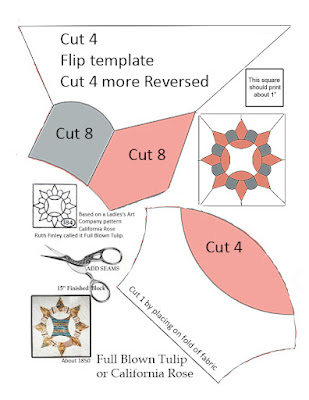One of my favorite patterns, this one offered a few years ago by
Molly at Fourth Corner Quilts.
Los Angeles County Museum of Art
They call it "Full Blown Tulip.
Red and green calico blocks alternate with a chintz
pillar print in a blending of two styles---two ways of looking at fabric.
Same pillar print from Winterthur Museum's collection
Julie Silber's inventory. Chintz and calico?
1840s?
About 1840 the fashion for large-scale furnishing prints in a busy composition was
replaced by a trend to use smaller scale calico prints. The Full Blown Tulip blocks are
the new idea; the chintz becoming old fashioned.
Ruth Finley in the 1929 book Old Patchwork Quilts called the design
"Full Blown Tulip" with a photo of a Turkey red, green and chrome orange & yellow quilt:
The height of quilt fashion about 1850.
So how old is this rather complex design?
The earliest examples are variations in a quilt dated 1842 & 1843.

Philadelphia Museum of Art
Other date-inscribed examples:
1842-1844 Henry Ford Museum
Philadelphia, Bucks County & Chester County names
They call it a Reel Variation.
American Museum of Folk Art
1842-1843, Sarah Morrell
Lisa Erlandson Collection
1844 Sarah A White
Annapolis, Maryland
Michigan State University Collection
1845 Abraham Messler, Somerville, New Jersey
Messler was a minister in the Reformed Dutch Church.
1845 Album Sampler with Donoho & Young family
names, Maryland Historical Society
The dated examples indicate the design came in with the trend for red & green calicos, 1842-1845, later than I would have guessed.
BlockBase+ patterns numbered 36xx
It's a challenge to piece yet many pattern companies offered variations over the years. Some drafted them better than others. Number 3653 had good proportions and is well drawn but if you will notice neither Finley's photo nor the Ladies Art Company's California Rose tells you how to fit it into a block.
Probably some skillful piecers in the 1840s did not fit it into a square block but pieced it into another odd shape. As my computer program is BLOCKBase we fit it into a block---in a circle, but pieced edges might be better.
About 1950 from my collection
Online Auction
I redrew the BlockBase pattern for a 15-inch block.
Print on an 8-1/2" x 11" sheet.
In 1929 Ruby Short McKim published a pattern
in the Kansas City Star called Strawberry. She added an extra
seam in the petals.
BlockBase #3640
McKim's name from a mid-20th-c sampler.
A few years later an Oklahoma reader sent another version to the Star.
A real challenge. BlockBase #3637.
1938 Chicago Tribune version
Variations have many names. I'm not going to count them all. I've always liked Victoria's Crown, another Finley name, although I have no idea how old that name actually is.
Online Auction


















































gBWk~$(KGrHqQOKiQE)9,GPRmLBMmqdv4)j!~~_12.jpg)









